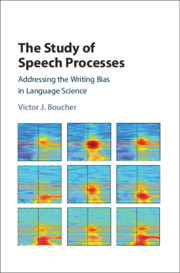Book contents
- The Study of Speech Processes
- The Study of Speech Processes
- Copyright page
- Contents
- Figures
- Tables
- Abbreviations
- Preface
- Introducing a Fundamental Problem of Language Science
- Part I Questions of Ontology: Writing and the Speech–Language Divide
- Part II Questions of Epistemology: The Role of Instrumental Observations
- Part III The Structure of Speech Acts
- 6 Utterances as Communicative Acts
- 7 Relating to Basic Units: Syllable-Like Cycles
- 8 Relating Neural Oscillations to Syllable Cycles and Chunks
- 9 Breath Units of Speech and Their Structural Effects
- Part IV The Processing of Speech Meaning
- References
- Index
8 - Relating Neural Oscillations to Syllable Cycles and Chunks
from Part III - The Structure of Speech Acts
Published online by Cambridge University Press: 14 January 2021
- The Study of Speech Processes
- The Study of Speech Processes
- Copyright page
- Contents
- Figures
- Tables
- Abbreviations
- Preface
- Introducing a Fundamental Problem of Language Science
- Part I Questions of Ontology: Writing and the Speech–Language Divide
- Part II Questions of Epistemology: The Role of Instrumental Observations
- Part III The Structure of Speech Acts
- 6 Utterances as Communicative Acts
- 7 Relating to Basic Units: Syllable-Like Cycles
- 8 Relating Neural Oscillations to Syllable Cycles and Chunks
- 9 Breath Units of Speech and Their Structural Effects
- Part IV The Processing of Speech Meaning
- References
- Index
Summary
The entrainment of neural oscillations to attributes of signals provides a key principle by which one can evaluate how the brain interfaces with structures of motor speech. For many authors, frequency-specific entrainment of delta (< 3 Hz) and theta (4–10 Hz ) oscillations to groups and syllable-size energy modulations define processing frames. However, there is little agreement on the type of information that is processed in the frames. A review is provided of diverging views on the role of entrainment and controversial claims that oscillations entrain to non-sensory units like words and phrases. A critical experiment is presented showing that, whereas theta oscillations entrain to acoustic attributes even in sequences of tones, delta entrains specifically to signature marks of chunking in speech stimuli regardless of whether the stimuli are meaningful utterances or meaningless series of syllables. By this evidence, delta waves do not entrain primarily to putative syntactic units but more generally to chunks of articulated sounds, which is consistent with a body of evidence demonstrating that chunking is a domain-general principle involved in processing motor sequences.
Keywords
Information
- Type
- Chapter
- Information
- The Study of Speech ProcessesAddressing the Writing Bias in Language Science, pp. 172 - 181Publisher: Cambridge University PressPrint publication year: 2021
